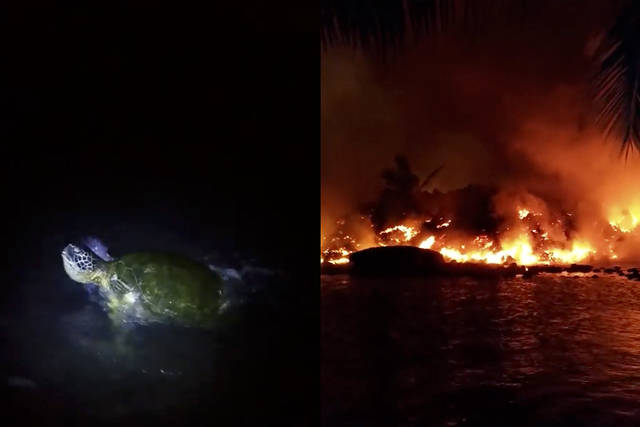Green sea turtles struggle to escape near-boiling water of Champagne Ponds in Kapoho Bay


COURTESY TRAVIS SANDERS
This screenshot of a video taken by Puna resident Travis Sanders shows a turtle, one of several he saw on June 3, trying to escape the near-boiling water of Champagne Ponds in Kapoho Bay.


Green sea turtles trapped in ponds and nearshore waters superheated by lava have been dying, says a Puna resident who contends that governmental agencies have ignored pleas for help. State officials say they have searched for the turtles but have not found any in danger.
Puna resident Travis Sanders shot video in June of a turtle, one of several he saw that night, trying to escape the near-boiling water of Champagne Ponds in Kapoho Bay with lava in the background. It has been viewed about 1,000 times, and he informed authorities at a June 9 meeting of the turtles’ plight.
He estimated seeing about 60 turtles in mid-July gathering along the shore near the Bowls surf spot between the Pohoiki boat ramp and the ocean entry of the lava.
On Tuesday, the Department of Land and Natural Resources issued a statement saying that “DLNR and NOAA (National Oceanic and Atmospheric Administration) Fisheries are aware of these postings but so far there has been little actionable information.”
DLNR on Wednesday sent representatives in a Coast Guard C-130 plane over the area and said, “to the naked eye no turtles were visible.”
DLNR did a flyover July 17 along with a short land check near Pohoiki boat ramp and the Hawaii County Fire Department sent a helicopter after the first reports, but did not see any turtles in trouble, state officials said.
Don't miss out on what's happening!
Stay in touch with breaking news, as it happens, conveniently in your email inbox. It's FREE!
Sanders said, “By the time they went, it was already too late … It’s really upsetting.”
Sanders said he brought it to the attention of DLNR and federal agencies at a June 9 meeting at Panaewa Zoo where they discussed rescuing farm animals. Officials took notes and assured the public they would address all the issues, he said.
Sanders and others say the turtles are trapped between the hot water and the shore, so they sought refuge in the cold spring water coming out along the shore. “Some people say it’s nature; I say it’s natural to help,” he said.
“The turtle came up to me and looked straight at me, trying to get out of the water,” on the turtle’s second pass as it frantically circled the small pond, said Sanders. “It was asking for help at that time. That turtle could have gone anywhere else in the dark large pond, but the fact that he came to me twice” indicated he wanted help.
Sanders stuck his finger into the simmering water, and estimated the it was just below the boiling point, and he had no net. On the second pass, he said, “I tried to pull him out but his legs fell apart. He was boiled alive.”
“After that happened, he was sliding back into the water, spun in a few circles for about 30 seconds and died. I couldn’t reach him with no net. There’s nothing I could do. … You could feel its spirit leave.”
Sanders said that the turtles were in a pond system and couldn’t escape, but could have been rounded up.
“The Honu (sea turtles) have been climbing over each other at low tide in order to get closest to the cool water streams coming from inland,” said Tony Johnson on a Facebook post. “I witnessed around 40-60 Honu one night at low tide in front the last parking spot under the trees…loving the cool water.
“I believe the ocean entry has pushed south so quickly that the current pushing south from the flow is WAY too hot for them to cross or they just are afraid to try.”
DLNR said: “While it is unknown how many turtles may have lived in or around Kapoho or Pohoiki, it’s believed most turtles had access to the open ocean via channels or open fish pond gates, and that they were able to swim away and save themselves before being harmed by the lava flow.”
Brian Neilson, DLNR Division of Aquatic Resources acting administrator, said the agency has learned some lessons and started discussion among agencies regarding proactive measures. “Human safety is of primary concern and everyone should follow official guidance regarding access in the area,” he said.
DLNR quoted a lava tour boat operator who said it would be difficult to save turtles along the coastline as the water is turbid and murky and hard to spot them up close from the shoreline.
NOAA and DLNR experts say even if they could have reached turtles, “relocating these wild animals is fraught with challenges.”
Reports of stranded animals must come within a few hours of the incident, include photos and provide information about a safe, accessible location for responders, DLNR said.
NOAA’s marine animal stranding and hotline is (888) 256-9840 or call DLNR’s hotline at 643-3567.




